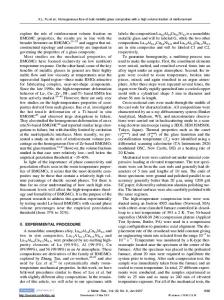Volume Fraction of Graphene Platelets in Copper-Graphene Composites
- PDF / 432,323 Bytes
- 8 Pages / 593.972 x 792 pts Page_size
- 25 Downloads / 340 Views
RGE scale preparation of graphene that can be used in the processing of composites is best carried out by chemical exfoliation of graphite oxide (GO).[1,2] In this process, microcrystalline graphite is oxidized using concentrated sulfuric and nitric acid mixture with addition of hydrogen peroxide to achieve complete conversion. The resulting brown color GO is washed to remove the residual ions. The purified mixture dispersed in deionized water is exfoliated using sonication for a prolonged time. The suspension of GO is maintained without sedimentation. This procedure while suitable to achieve large scale production of GO gives rise to smaller size platelets with a distribution of size and thickness that is characterized using scanning electron microscopy (SEM) and quantitative metallography prior to processing of composite.[3,4] The thickness variations are not easily evaluated as it requires use of atomic force microscopy[5] or Raman spectroscopy characterization[6] that takes longer time for a large number of particles to be analyzed. Thus, the GO is in the form of platelets. Thickness variations in the exfoliated graphene have been established using the K. JAGANNADHAM, Associate Professor, is with Materials Science and Engineering, North Carolina State University, Raleigh, NC 27695-7907. Contact e-mail: [email protected] Manuscript submitted May 20, 2012. Article published online September 6, 2012 552—VOLUME 44A, JANUARY 2013
centrifuging of the graphene in solution.[7] The GO platelets are reduced to graphene during processing the composite.[3,4] We have found[8,9] SEM imaging in the backscattering mode can be used to identify graphene as carbon with low atomic number provides dark contrast. However, the thinner graphene platelets (GNP) provide weak contrast. In addition, the interaction of the electron beam with GNP beneath the surface of the sample also provides weak contrast. The thicker GNP provides strong contrast. Therefore, quantitative metallography techniques using fast acquisition and image analysis are not suitable for the determination of thickness and volume fraction of GNP in the composite. These two parameters are important in the modeling of properties of the composites. Transmission electron microscopy (TEM) while useful for characterization of microstructure and defects is not helpful for determination of volume fraction from much larger scale imaging. In the present work, a low cost electrochemical deposition was used to prepare the copper-graphene (Cu-gr) composite films with different volume fractions of graphene.[8,9] The electrical resistivity, temperature coefficient of electrical resistance, and thermal conductivity of the Cu-gr composite samples were measured and the results correlated with the volume fraction of graphene using effective mean field analysis (EMA).[3,4,8,9] The thinner GNP in the present work refers to graphene thickness below three atomic layers. The thinner GNP exhibits higher electrical conductivity.[10] The thicker METALLURGICAL AND MATERIALS TRANSACTIONS A
GNP r
Data Loading...










